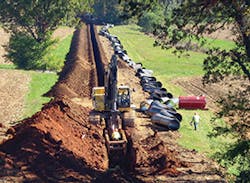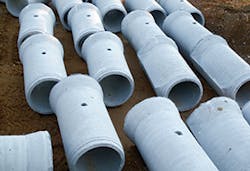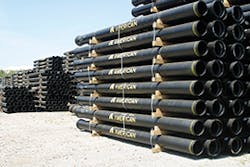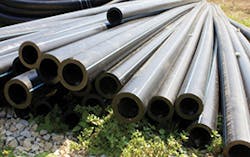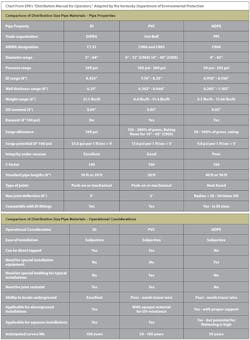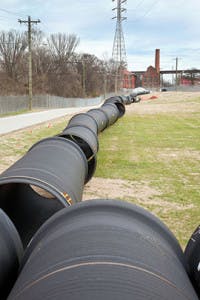Like a patchwork of odd bits and pieces preserved from earlier times, the nation’s water infrastructure mixes a legacy of diverse pipe materials. Some quaint and quasi-experimental oddities once had their day as ductwork. Reportedly, there was, or is, asphalt impregnated cardboard, asbestos concrete, PVC truss pipe, and drywall gypsum, and, even, hollowed-out logs and wood-lined channels.
Of course, there’s plenty of cast iron (CI) left from as long as 100 years ago. In time, CI was superseded by ductile iron (DI).
And, since the late baby boom days of about 50 years ago, there’s been a huge trend to plastics, especially PVC, polyethylene, HDPE, and fiberglass, some for clean water distribution, some for waste collection.
Somewhat mirroring the diverse housing styles at ground level, these variegated materials are patched together below. Measured as a combined span, they total more than 1 million miles of US water delivery, according to the AWWA.
It’s a branched network, and one that’s become notoriously leaky and in need of frequent repair at very high cost. Everything that can be done to preserve pipe integrity by using the best materials and installation procedures, and thus postponing the next cycle of decay, will pay huge dividends in water savings for decades to come.
But, for now, it’s a leak-prone system that’s also sometimes “hard to reach,” as noted, for just one particular example, by Clayton Getz of Kentucky’s Department of Environmental Protection (DEP), division of compliance assistance.
In the following discussion, Getz describes conditions which might easily apply to hundreds of localities across the country. “In older parts of town,” he says, “under main streets, you have original pipes that were laid many decades ago…. The city has outgrown them, and maybe ignored them. They’ve been in the ground too long, and have gone too many years without being maintained or cleaned.”
Constant flow pressure inevitably leads to steady leaks. They’re tolerated, only because the cost of doing a comprehensive, systemwide repair is so horrendously prohibitive. Then, at last, a dramatic line break occurs: puddles form on the ground above, and maybe cave-ins, as the rupture becomes impossible to ignore any longer.
What’s Clearly the Right Replacement?
It depends on a number of factors and, equally, the people with whom you speak.
Culverts made of concrete ready to be used
Answers to the piping debate reflect expert views on materials and sizing, but there’s a growing consensus that what’s “right” is simply determined by whatever’s easiest on today’s budget—not necessarily what’s right for the long term.
So it seems that cost alone (tallying the materials, transport, installation labor, etc.) trumps other considerations. In practice, price ends the debate. A water agency will receive multiple bids for a given job; all presumably meet the specifications. Almost invariably, the low one wins.
Getz observes, “Money is the driving factor in cost decisions. For every operator I talk to, it’s all about green figures,” i.e., dollars.
And water operators often have little say on how much money is available, for pipes or anything. Talk of raising rates is usually a dead end, adds Getz, who participates in the training, testing, and certifying of Kentucky water system operators and technicians.
A similar conclusion comes from Richard St. Aubin. He’s currently director of business development for IPEX
Inc., one of Canada’s market-leaders in the design and manufacture of integrated thermoplastic piping systems, especially PVC, polyethylene, chlorinated PVC, and polypropylene. St. Aubin was formerly with the City of Hamilton, Ontario Public Works Department, doing the pipe selection and such.
“These are low bid projects,” notes St. Aubin. “Cost is not only significant—it’s the only driver.”
It’s also a virtually unanimous opinion that plastic piping is cheapest, both as a material, and in its installation rigors. Being much lighter than iron, it is easier to haul and handle. The number of competitive plastic makers is also growing worldwide, while iron forges are dwindling.
For these cost reasons and others, plastic pipe has been on a tear for years, steadily taking over the market. St. Aubin reports that plastics now own about 90% of Canada’s piping business, according to a survey by a national PVC pipe association. In the US, he estimates that plastics dominate with about 60% or 65% of sales. The balance goes predominantly to DI.
As for the latter, besides being costlier, iron suffers from its well-known vulnerability to corrosion, both from what’s in the pipe and from outside. St. Aubin and others say that in diameter sizes of less than 16 inches, plastic pipe now completely dominates. In these small diameters, DI is relegated to very limited roles, such as pipes lying shallowly below railroad tracks.
Above that width, though, there’s more of a mix of DI, concrete pressure pipe, plastic, and steel, all observers agree.
Plastic, being cheap and popular, also enjoys acclaim for ever-improving performance in durability and longevity.
Here, St. Aubin cites a 20 year-old study by Canada’s National Research Council, later replicated by Utah State University. Plastic pipes were found to have a much lower rate of breakage than either DI or CI.
The latter, St. Aubin notes, “can snap and shatter. It doesn’t have much give. A cold climate makes it even worse. DI is more bendable, and therefore is preferable to CI.”
However, in order to make DI more competitive against the plastic newcomers some decades ago, DI was made
much thinner than CI. Thin DI pipes were laid.
Subsequently, and unfortunately, says St. Aubin, “Over the years, we’re now seeing higher failure rates on ductile iron than on cast iron, since the latter is extremely thick and durable.”
Plastic pipe wins even stronger love for its capability of being improved in the laboratory. Several such major molecular innovations are now newly arriving, and are discussed below.
St. Aubin describes one, for example, which appeared about five years ago. IBEX introduced a new PVC variant called Oriented PVC (PVCO). Today, though still quite new, PVCO pipe is quickly gaining acceptance. AWWA recently recognized PVCO with a new standard. As he explains, PVCO functions like conventional C900 PVC piping, but is much stronger.
“The impact strength is improved by a factor of five or six,” he says. “You can take a six-inch diameter PVCO pipe and hit it with a sledge hammer as hard as you can, and it’s not going to break.”
When subjected to heat, it becomes even stronger. Being so much stronger also means PVCO pipe can be produced with thinner walls, allowing more water to be transported at the same diameter size.
Iron Pipe in Reply
Before continuing discussion of the plastic takeover, here’s a compelling argument in favor of iron. It’s from Maury Gaston, Marketing Services Manager of the American Cast Iron Pipe Company (Birmingham, AL).
“New isn’t necessarily better,” begins Gaston.
He suggests that plastic piping may someday reveal long-delayed health hazards, similar to those that were discovered belatedly and brought about the demise of asbestos-laced construction materials, including asbestos-cement pipe.
More positively, Gaston notes that iron is still known and respected for its amazing durability. “More than 600 utilities have iron pipe systems in continuous service for more than 100 years,” he reports.
Iron is also “many times stronger than plastic.” Comparatively, “PVC pipe becomes brittle in colder temperatures and softer in higher temperatures,” he adds.
The Ductile Iron Pipe Research Association (DIPRA) adds further affirming discussion, noting the following points, most of them compelling. (These can be found at the DIPRA website.)
- Engineers have long supported ductile iron pipe’s superior durability and high quality when compared to PVC pipe.
- Ductile Iron has 10 times the impact strength, nine times the tensile strength, and four times the burst strength of PVC pipe–and, unlike PVC pipe, it can handle stress.
- The cost to pump water through PVC pipe is as much as 38% higher than that of ductile iron pipe.
- PVC pipe is sensitive to installation miscues. It cannot withstand relatively minor scratches, and extra care must be taken to avoid large rocks, frozen lumps, and debris. A scratch no deeper than the thickness of a dime can ruin an entire length of PVC pipe.
- Ductile iron pipe is not affected by temperature changes, while PVC pipe becomes brittle in colder temperatures and weaker in higher temperatures.
- In about one year, PVC pipe can lose 34% of its impact strength from exposure to the sun–which has no impact on ductile iron pipe.
- Direct tapping of ductile iron pipe is easier, safer, less expensive, faster, and less likely to damage the pipe than PVC tapping. On the other hand, tapping PVC pipe can result in cracked pipes, injured workers, and costly flooding until the repairs can be made.
- Locating ductile iron pipe is effortless. PVC pipe requires that locating wires be installed in the trench.
Fiberglass, From Europe to Texas
Longtime water system designer Clete Martin has been a senior project manager for about 25 years. Currently, he’s with Alan Plummer Associates, a consulting engineering firm based in Fort Worth, with a half-dozen other offices in the Southwest.
Martin does water system engineering exclusively. In his practice, he’s always striving to design “the most economical pipe system over the service life of the pipe.”
It should be no surprise that Martin and his colleagues at APA often wind up specifying plastics—PVC, HDPE, or fiberglass, he says. These materials are all suitable for the vast majority of water and wastewater distribution scenarios. Fiberglass is especially good for sewer gravity pipes. Nevertheless, he says, when pipe diameters exceed 16 inches, there’s still a role for DI (or steel or concrete cylinder), especially for water mains or other higher-pressure transmission pipes.
That said, CI should now be considered more or less obsolete, Martin says.
As for DI piping, because it requires special protection, he finds that his clients “would much rather have corrosion-proof material than a material like iron that needs multiple layers of linings and possible coatings and corrosion additions to it.”
Again, he notes that innovation with plastics is in progress continuously, and the results are impressive. This point is perhaps the story for pipe specifiers, he adds.
Just within the past several years, for instance, Martin has seen PVC pipe diameters being engineered and introduced at much larger diameters than ever, up to 48 inches in size.
“Now they are trying to go to 60 inches for PVC pressure pipe,” he adds. “I’m not sure we’re ready for it yet, but that’s what they’re trying to do.”
At this huge diameter, PVC transmission pipes would be subjected to stressful, repeated pressure surges. That reality will first require rigorous lab and field testing.
Coming somewhat out of left field, fiberglass is now emerging as a truly viable piping option, he says. This material, which is suitable for any water but particularly for corrosive wastewater, “has already passed all of this very strenuous testing,” he points out. “So, the emerging market that I’m seeing is for fiberglass in high-pressure pipe, in large sizes.”
Compared to other plastics or DI, Martin contends that in the US, “fiberglass is still relatively an outsider here.” It’s used much more extensively in Europe, though, which is “well ahead of us” on plastic and piping innovations, he adds.
Currently, fiberglass piping is common only at industrial sites, rather than for city water—but is gaining a reputation. In the Southwest, it affords “excellent protection against internal corrosion of wastewater and external due to soils,” he says.
Just like everywhere else, Texas’ belowground piping is falling apart, Martin notes. The Southwest’s climate, being extremely dry and alternating hot and cold, accelerates decay, and stresses pipe exceptionally. Texas is now beset with leaks. Drought years and winter freezes have caused contraction and pipe impaction. Major water line breaks are not uncommon.
The remedy here, Martin suggests, is for water system designers to search for and specify the hardiest materials that will last much longer than the mandatory 50-year minimum.
That’s a long time, but not long enough for Martin, who says, “Our children and grandchildren cannot afford to replace infrastructure every 50 or 75 years.” Everyone should be targeting 100 years, instead. Unfortunately, human nature makes it difficult to invest in farsighted results that greatly exceed our own professional careers and life spans.
It’s of supreme importance now, he says, “to understand the AWWA standards in depth, and then go way beyond them,” if possible, in water delivery design.
Latest-Generation HDPE Impresses
Another newcomer, HDPE plastic, only received AWWA recognition as recently as 2008, with the publication of ANSI/AWWA C901, which included PE 4710, notes Camille George Rubeiz, P.E. He is Director of Engineering (M&I) for the Plastics Pipe Institute, based in Irving, TX.
Moreover, Rubeiz adds that it was just in July 2013 that AWWA reaffirmed HDPE pipe distribution and transmission standard C906.
Again, Europe has been way ahead of North America on this particular material, he notes. There, HDPE pipe [PE4710/PE100] has been in use since 1990; it now enjoys fully a 90% market share of new water pipe installations.
Domestically, AWWA’s and ANSI’s belated embrace of HDPE will now enable water distributors “to take advantage of the enhanced performance properties of the newer class of PE4710…and its corresponding design approach [which will] result in greater performance safety….” says Rubeiz.
PPI’s Executive Director Tony Radoszewski proclaims HDPE as the pipe material of choice.
“Under most conditions, it will have a service life in excess of 100 years,” he states.
Rubeiz, too, describes HDPE as a next-generation improvement over PVC. Contrary to the vulnerability of competing plastics, HDPE will not rupture when water freezes solid inside it, and if freezing is a concern, HDPE piping can be prepared in advance to enable thawing, he notes.
HDPE is also a ductile material with exceptional impact strength. It can “shed” stresses, enabling it to resist failures in a way that more rigid plastics cannot, Rubeiz states. An HDPE piping system is thus nearly impervious to conceivable impact damage. This quality has been demonstrated repeatedly by its survival amidst earthquakes, hurricanes, floods, droughts, and tsunamis. Rubeiz offers several examples:
- A Water Research Foundation assessment of earthquake damage in Chile, Christchurch, and Japan found “thousands” of failures of small-diameter distribution pipes of assorted materials, “many” failures of large-diameter transmission pipes, but no failures of HDPE.
- Identical results followed Hurricanes Katrina and Rita along the Gulf Coast.
- A study by the National Association of Corrosion Engineers found that annual corrosion damage of all utilities’ pipes costs about $36 billion; of this, the portion of HDPE corrosion came to zero.
- Rubeiz reports that the AWWA has also found HDPE impervious to leakage. AWWA M36 (2009) tabulated water losses in other pipe materials, based on pressure and size of hole; outflow ranged from 1 gallon per minute up to 1,350 gpm, with some agencies losing as much as 60% of their water this way. In contrast, the leakage for properly fused HDPE mains was again zero, per AWWA M55, he notes.
- Another report, from Jana Lab, states: “PE4710 materials…are capable of providing for essentially unlimited fatigue resistance under the operating conditions of water.” By contrast, “PVC materials are seen to be susceptible to fatigue under the operating conditions of water transmission and distribution systems.”
- EPA’s asset management handbook states that properly designed, installed and maintained HDPE distribution pipe and transmission mains are projected to exceed a lifespan of 100 years. By contrast, small water systems’ present distribution pipes and transmission mains yield an estimated life of 35-40 years.
- The combined benefits of lower maintenance, lower installed cost, and savings on water leakage, significantly lower the lifetime cost of HDPE, vis-a-vis both ductile iron and PVC. Rubeiz cites an unnamed California water company that installed HDPE piping for its water system and saved 25% to 50% by using HDPE trenchless installation.
On the negative side, Rubeiz concedes that installation of this material is perhaps a bit trickier than PVC.
However, he states, “With proper tooling and experienced installers, high-quality fusion joints are prepared per ASTM F2620 that provide a self-restraining, leak-free system, and eliminate kickers or anchors associated with non-self-restraining materials/systems….” This further reduces installed cost.
He sums up: “Service taps can also be connected by fusion methods, providing yet another leak-free connection requiring minimal future maintenance.”
What About Sizing?
Back in Kentucky, PVC piping is favored overwhelmingly, Getz reports. It’s now used about 80% of the time “for
5,670 feet of ductile iron pipe was used
in the 2012 water main upgrade at the
Omohundro Water Treatment Plant.
almost everything,” he says, although his office doesn’t officially make recommendations about any material.
Regarding HDPE he does admit that, “We really like it. We call it ‘contractor-proof’, because it is so strong that even when a backhoe is pulling up on HDPE pipe, the ground literally comes up beside you. It’s pretty sturdy pipe.”
Decisions about piping, he says, are made locally. Typically, they’re determined by someone intimately familiar with the system in question—either a well-known consulting engineer specialist or the system owner-operator himself.
Local soil chemistry is considered, as is currently used piping and the number of service connections, although Getz laments that, “Once an operator finds a material they like, it’s hard to get them to change.” In state-mandated training classes he emphasizes the need for flexibility and being open to new options.
As for sizing, decision-making about diameters would seem to be automatic, based on “water flow volumes, pressure needs, numbers, and types of connections,” says Getz, along with factoring-in some thought about desired pipe lifespan, soil corrosive characteristics, and ease of doing future repairs. Judgment and experience come into play again, but, unfortunately, this may simply perpetuate practices that have not been reviewed and updated in light of developments.
Water agencies occasionally do err on sizing decisions, for various reasons. The results are then usually manifested by problems with hydraulics. Mistakes often become evident fairly soon, as water pressure is constantly monitored, and divergences are flagged.
Getz offers some scenarios on how sizing mistakes may happen.
For one: a system may have been initially designed for 12-inch pipe, then supplemented over time with spans that drop the diameters to 8 inches, and then to 6.
“The operator doesn’t realize the drop to six inches is only going a couple of hundred feet,” explains Getz. “You will lose a lot of high pressure when your water is going through those pipes and it’s dropping down in size.”
The remedy is to resist knee-jerk application of practices. Instead, “to take the time and effort needed to calculate how to equalize pressure whenever pipe sizes change,” he advises.
Correct sizing can also be made trickier by the fact of dynamically changing demand conditions, i.e., system growth or decline. It’s especially challenging and critical to predict how much flow capacity will be needed for future generations who will be served many years from now by piping decisions made today.
Getz illustrates with a couple of other examples: Suppose an old, 2-inch galvanized pipe has 14 service connections. The operator might naturally think that when replacement of this pipe is needed, it should be fitted with, say, a new PVC plastic span that is identical in length and diameter. In fact, though, this measure might prove to be a mistake. “With 14 connections already on there, it’s not going to have great pressure,” he adds. “So if there’s that much demand already, you would go in and double it up, to help out the customers.”
Getz suggests increasing the diameter to 4 inches to handle the increased flow and maintain pressure.
Another example: an 8-inch pipeline stretches a mile into a rural area. A water agency operator has followed conventional sizing tables to specify this diameter—without realizing that this particular pipe has only one service connection on it, and very little prospect of ever getting many more. There’s very little flow.
Thus, says Getz, “The operator winds-up having to flush that every night to get any kind of material or residue out, because there is no turnover in the water.”
This is, of course, extremely wasteful and inefficient. So, although a table specified 8 inches, “This is not the right time and right place for that pipe,” he says. An operator and system designer must obviously look carefully at local conditions when sizing, and adjust accordingly.
In a fourth example, Getz recounts that “several operators have come to me wanting to connect a “˜tree’ grid system,” i.e., water distribution “to an older section of town with iron pipes down Main Street, and branches off this.” The main and delivery lines come to dead ends currently. This is an undesirable arrangement because water in the pipe stagnates.
Getz comments: “Many of our operators are experienced enough to realize they need to connect those dead ends” with right-sized plastic spans “so they can loop the system so the water quality improves.”
And, Getz encourages this. However, occasionally there will be raised eyebrows from water board members or town managers who don’t understand why pipe is being laid but no new connections added.
Leaky Pipe Pandemic “Buried No Longer”
To sum up, it may be valuable to heed a recent warning from AWWA.
Urban water systems, typically built decades ago during booms, are now crumbling “all at once,” as it were. More than a few systems seem on the verge of catastrophic, widespread failure.
The scale of the crisis is outlined in AWWA’s alarming 2012 study titled “Buried No Longer: Confronting America’s Water Infrastructure Challenge.” It’s a sequel to an earlier AWWA paper, “Dawn of the Replacement Era.”
In both, AWWA presents evidence that widespread pipe failures are looming. This is especially the case with cast iron materials installed as long as a century ago, and ductile iron more recently. Due to unexpectedly harsh corrosive ground conditions in many places, and early pipe-laying practices, both ductile and cast iron—he nation’s water delivery backbone—are in serious decline.
When failures do occur, repair costs will be comparatively enormous. AWWA suggest a cumulative US figure of about one trillion dollars over the next 25 years, and 1.7 trillion by 2050. For each US household, those numbers work out to many hundreds of dollars annually, for a very long time. Costs for some may run higher, amortized over decades, as local water systems will suffer disproportionate damage and the repair burden.
All in all, many water customers will eventually encounter a tripling or more in their water delivery costs—and this at a time when rate increases will be extremely difficult.
Every effort taken to select and install the highest quality, longest-lasting pipe materials will bring relief and gratitude, if not for present customers, then at least for generations of future ones.